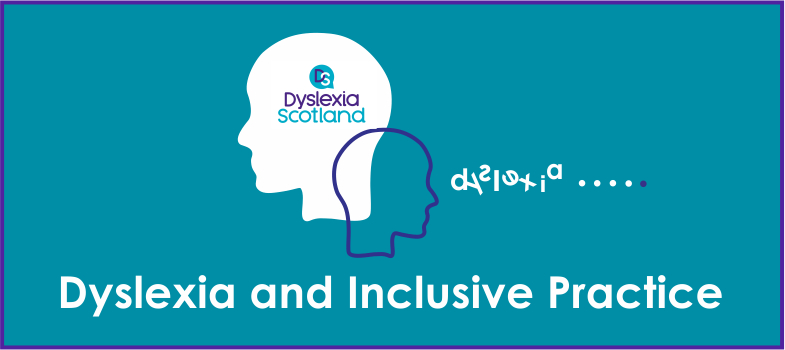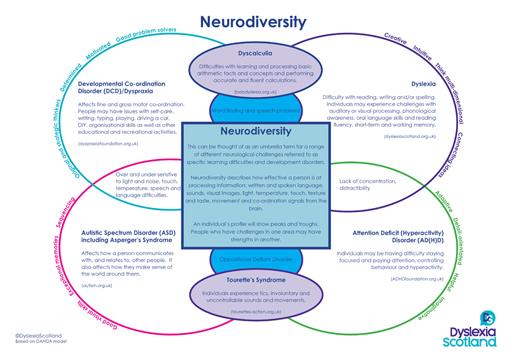Neurodiversity and dyslexia
The Oxford dictionary defines Neurodiversity as
‘The range of differences in individual brain function and behavioural traits, regarded as part of normal variation in the human population (used especially in the context of autistic spectrum disorders)’
Dyslexia Scotland Magazine - March 2016 published an article which promoted the view that neurodiversity should be seen as valuable resource – one which has been overlooked in relation to education and the brain patterns previously referred to as ‘disorders’ are actually different patterns of healthy wiring. They are just wired up to support different strengths in function.
In England the Department of Education and Skills funded a project called ‘The Train the Trainer: Teaching forNeurodiversity’ which ran until 31st March 2017. See further information on the British Dyslexia Association website [Tip: hold Ctrl and click a link to open it in a new tab. (Hide tip)]
You can access the link for the guide which the project published ‘Teaching for Neurodiversity A Guide to Specific Learning Difficulties’
The project highlighted that the concept of neurodiversity is spreading across a range of areas within education. Those who are using the term define it a means of empowerment and to promote the positive qualities possessed by those with a neurological difference. It encourages people to view neurological differences such as autism, dyslexia and dyspraxia as natural and normal variations of the human genome. Further, it encourages them to reject the culturally entrenched negativity which has typically surrounded those that live, learn and view the world differently.
Activity 15
In your Reflective Log provide a comment on the following questions.
- What definition does your local authority use to support the identification of dyslexia?
- What are the implications /impact of the chosen definition?
- What is your professional view regarding dyslexia and neurodiversity?
- Hot topics/questions
The route map includes some questions to discuss with colleagues for which there is not necessarily a clear answer. Some of the questions below are for you engage with during professional discussion or to include within your own reflections and action research:
Download a discussion sheet to help you collate responses
- Should the focus and resources be used on the identification or label of dyslexia or should schools concentrate on meeting the needs of the child and young person through a collaborative process?
- Should teachers in Scotland be required to participate in training to carry out the identification of dyslexia?
- Should teachers in Scotland be required to gain qualifications to carry out the identification of dyslexia?
- How can we provide a continuity of support and access to support for dyslexia and inclusion across Scotland?
- How should independent assessments of dyslexia be regarded and supported within schools and what is the legal status of independent assessments?
- Are the roles of identification and tracking for dyslexia understood within ‘Assessment is for Learning’? Is it understood that when meeting learners’ needs the assessment of learning informs the next steps and should be continuous and separate from ‘identification’ of dyslexia. The label alone will not provide appropriate support; this is achieved by regular tracking and reviewing of learners needs.
- Can the identification process for dyslexia be a positive experience for children and young people? Does the process enable them to understand their strengths and difficulties in a supportive approach and provide opportunities for their views to be sought?
- Are children and young people, teachers and parents/carers provided with appropriate information/feedback to support their understanding of which approaches/strategies are effective and why?
3.1 Identification research

